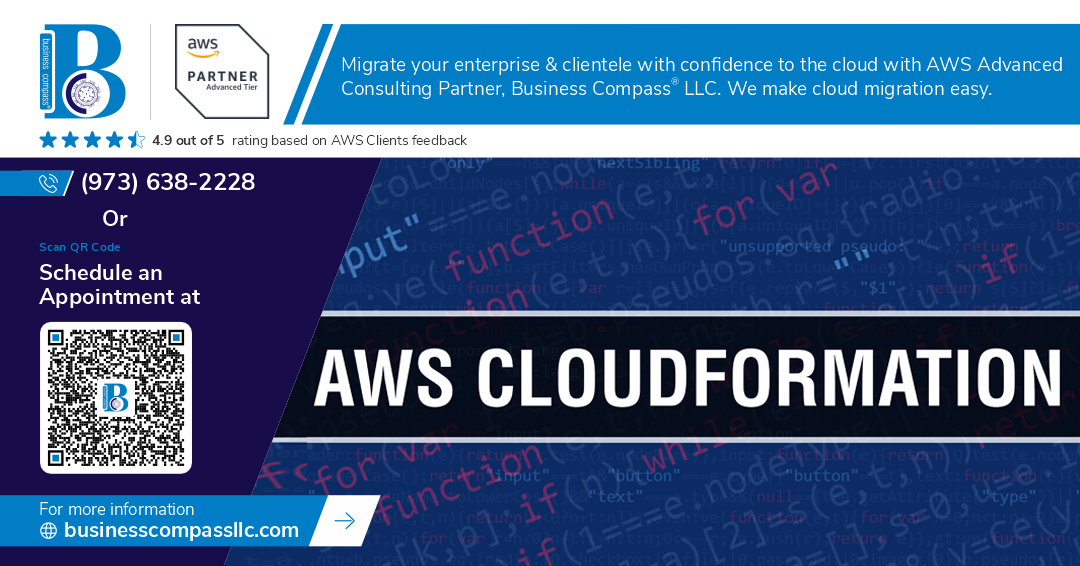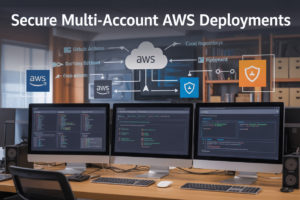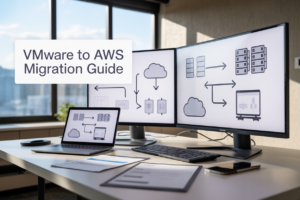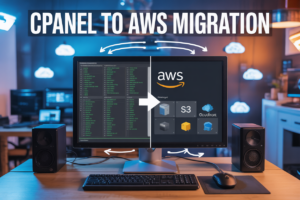Managing AWS infrastructure manually becomes a nightmare as your applications grow. AWS infrastructure automation with Python CloudFormation transforms this chaos into organized, repeatable processes that scale with your business needs.
This guide targets DevOps engineers, cloud architects, and Python developers who want to build scalable cloud infrastructure without drowning in manual configuration tasks. You’ll learn to create robust systems that deploy consistently across development, staging, and production environments.
We’ll start by setting up your Python development environment for AWS and establishing the foundation for infrastructure as code Python workflows. You’ll discover proven CloudFormation template design patterns that eliminate common deployment headaches and make your infrastructure maintainable.
Next, we’ll dive into AWS automation with Python techniques that go beyond basic templates. You’ll master automated AWS deployment strategies for multi-environment deployment AWS scenarios, ensuring your applications scale smoothly from prototype to production. Finally, we’ll cover AWS DevOps automation best practices for monitoring and maintaining your cloud infrastructure scaling operations long-term.
By the end, you’ll have the skills to build infrastructure that grows with your needs instead of holding you back.
Understanding AWS Infrastructure Automation Fundamentals
Define infrastructure as code and its business advantages
Infrastructure as code (IaC) transforms how organizations manage cloud resources by treating infrastructure configurations as software code. Instead of manually clicking through AWS consoles, teams write declarative templates that define their entire infrastructure stack. This approach brings version control, repeatability, and collaboration to infrastructure management. AWS infrastructure automation through IaC eliminates configuration drift, reduces human errors, and enables rapid scaling. Teams can review infrastructure changes like code reviews, rollback deployments instantly, and maintain consistent environments across development, staging, and production.
Compare manual provisioning vs automated deployment costs
Manual provisioning creates hidden costs that compound over time. A single EC2 instance might take 30 minutes to configure manually, while automated deployment completes the same task in 3 minutes. For organizations managing hundreds of resources, this time difference translates to thousands of hours annually. Manual processes also introduce inconsistencies that lead to debugging sessions, security vulnerabilities, and downtime incidents. Automated AWS deployment eliminates these overhead costs while providing audit trails and compliance documentation. The initial investment in Python CloudFormation automation typically pays for itself within the first quarter through reduced operational overhead and faster time-to-market.
Identify key AWS services for automation workflows
AWS offers several services that form the backbone of scalable cloud infrastructure automation. CloudFormation serves as the primary infrastructure as code service, managing resource lifecycles through JSON or YAML templates. AWS CLI and SDKs, particularly boto3 for Python, provide programmatic access to AWS APIs for custom automation scripts. AWS Systems Manager automates patch management, configuration updates, and operational tasks across EC2 fleets. Lambda functions handle event-driven automation, while Step Functions orchestrate complex workflows. CodePipeline and CodeBuild create continuous integration pipelines, and CloudWatch provides monitoring and alerting capabilities that trigger automated responses to infrastructure events.
Assess when automation delivers maximum ROI
AWS DevOps automation delivers maximum return on investment in specific scenarios. Organizations with frequent deployments see immediate benefits from automated pipelines that eliminate manual bottlenecks. Multi-environment deployment strategies become cost-effective when managing more than three environments, as template reuse reduces configuration overhead exponentially. Companies experiencing rapid growth benefit from automated scaling policies that adjust resources based on demand patterns. Compliance-heavy industries gain significant value from automated audit trails and policy enforcement. The automation sweet spot typically occurs when infrastructure changes happen more than weekly, team size exceeds five engineers, or infrastructure complexity involves more than 20 interconnected resources across multiple AWS services.
Setting Up Your Python Development Environment for AWS
Install and configure AWS CLI and SDK tools
Getting your AWS tools set up properly forms the backbone of any successful Python CloudFormation automation project. Start by installing the AWS CLI version 2, which provides enhanced performance and new features for managing your cloud resources. Run pip install boto3 to add the AWS SDK for Python, giving you programmatic access to all AWS services. Configure your CLI using aws configure with your access keys, default region, and output format. Test your setup with aws sts get-caller-identity to verify connectivity. For development efficiency, install the AWS SAM CLI for serverless applications and consider adding the CloudFormation linter to catch template errors early in your development cycle.
Establish secure credential management practices
Security starts with proper credential handling in your AWS automation workflows. Never hardcode access keys directly in your Python scripts or CloudFormation templates. Use AWS IAM roles whenever possible, especially when running code on EC2 instances or Lambda functions. For local development, leverage AWS CLI profiles to manage multiple accounts and environments securely. Store sensitive configuration in AWS Systems Manager Parameter Store or AWS Secrets Manager, then retrieve them programmatically in your Python code. Enable MFA for your AWS accounts and regularly rotate access keys. Consider using AWS IAM Identity Center for centralized access management across multiple AWS accounts, making your infrastructure as code Python implementations more secure and maintainable.
Create reusable Python project structure templates
Building a consistent project structure accelerates your AWS DevOps automation efforts and makes your code more maintainable. Create a standardized directory layout with separate folders for CloudFormation templates, Python utilities, configuration files, and test scripts. Set up a virtual environment using python -m venv aws-automation-env to isolate your project dependencies. Include a requirements.txt file listing all necessary packages like boto3, PyYAML, and pytest. Create configuration templates for different environments (dev, staging, production) using JSON or YAML files. Add utility modules for common tasks like stack deployment, resource tagging, and parameter validation. Include logging configuration to track your automated AWS deployment processes effectively across all environments.
Mastering CloudFormation Template Design Patterns
Build modular templates using nested stacks
Nested stacks transform complex CloudFormation deployments into manageable, reusable components that scale across your AWS infrastructure automation projects. Break your monolithic templates into specialized stacks for networking, security, databases, and applications. Each nested stack handles specific resources while maintaining clear interfaces through parameters and outputs. This modular approach simplifies debugging, enables team collaboration, and accelerates development cycles. Stack references create parent-child relationships where the parent template orchestrates child stacks, passing values between them seamlessly. You can version control each stack independently, update components without affecting the entire infrastructure, and share common patterns across multiple projects. When designing nested architectures, establish clear boundaries between infrastructure layers and business logic components.
Implement parameterization for environment flexibility
Parameters make your CloudFormation template design patterns adaptable across development, staging, and production environments without code duplication. Define environment-specific values like instance types, security group rules, and database configurations as input parameters rather than hardcoding them. Create parameter groups for different deployment scenarios and use validation rules to prevent configuration errors. Default values streamline deployments while allowing customization when needed. Environment-specific parameter files store configuration values separately from templates, enabling automated multi-environment deployment workflows. Pseudo parameters provide access to AWS-specific values like region names and account IDs dynamically. Parameter constraints enforce acceptable ranges and formats, catching configuration mistakes before stack creation begins. This flexibility supports your Python CloudFormation automation scripts by eliminating template proliferation across environments.
Design resource dependencies for reliable deployments
Resource dependencies ensure CloudFormation creates, updates, and deletes infrastructure components in the correct sequence for reliable deployments. Implicit dependencies form automatically when resources reference each other through Ref functions or GetAtt attributes. Explicit dependencies use DependsOn attributes to control creation order when logical relationships aren’t captured through references. Database migrations, security group rules, and IAM policies often require explicit dependency management to prevent deployment failures. Circular dependencies break deployments, so design resource relationships carefully using dependency graphs. CloudFormation’s rollback mechanisms rely on proper dependencies to restore infrastructure safely when updates fail. Resource ordering becomes critical in scalable cloud infrastructure where services interact across availability zones and regions. Plan dependency chains that support both creation and deletion workflows, considering that deletion occurs in reverse dependency order.
Create custom resource types for specialized requirements
Custom resources extend CloudFormation’s native capabilities by integrating third-party services, legacy systems, and specialized AWS operations through Python Lambda functions. Build custom resources when standard CloudFormation resources don’t support specific configuration requirements or when you need to interact with external APIs during stack operations. The Lambda function handles Create, Update, and Delete events, managing resource lifecycle through your automated AWS deployment workflows. Custom resources enable infrastructure as code Python patterns for complex scenarios like DNS record management, SSL certificate validation, and application configuration deployment. Response objects communicate success or failure back to CloudFormation, including resource identifiers and output values. Error handling becomes crucial since custom resource failures block entire stack operations. Version your Lambda functions carefully and implement proper logging for debugging custom resource issues. Physical resource IDs help CloudFormation track custom resources across updates and deletions.
Integrating Python with CloudFormation for Advanced Automation
Automate stack deployment using Boto3 library
Boto3 transforms CloudFormation stack management from manual console clicking into programmable workflows. This Python SDK lets you create, update, and delete stacks with simple API calls, enabling sophisticated deployment pipelines that respond to business logic. Configure stack parameters dynamically, monitor deployment progress through CloudFormation events, and trigger deployments based on external conditions like code commits or schedule triggers.
import boto3
cf_client = boto3.client('cloudformation')
def deploy_stack(stack_name, template_body, parameters):
try:
cf_client.create_stack(
StackName=stack_name,
TemplateBody=template_body,
Parameters=parameters,
Capabilities=['CAPABILITY_IAM']
)
print(f"Stack {stack_name} deployment initiated")
except Exception as e:
print(f"Deployment failed: {str(e)}")
Generate dynamic CloudFormation templates programmatically
Python’s templating capabilities revolutionize how you build CloudFormation templates. Instead of static YAML files, create smart templates that adapt to different environments, instance counts, and configurations. Use Jinja2 templates or Python dictionaries to generate JSON CloudFormation templates that respond to runtime parameters, making your infrastructure code more maintainable and flexible across multiple deployment scenarios.
import json
def generate_template(instance_count, instance_type, environment):
template = {
"AWSTemplateFormatVersion": "2010-09-09",
"Resources": {}
}
for i in range(instance_count):
template["Resources"][f"Instance{i}"] = {
"Type": "AWS::EC2::Instance",
"Properties": {
"InstanceType": instance_type,
"Tags": [{"Key": "Environment", "Value": environment}]
}
}
return json.dumps(template, indent=2)
Implement error handling and rollback strategies
Robust AWS infrastructure automation demands bulletproof error handling that prevents partial deployments from breaking your systems. Implement comprehensive exception catching for CloudFormation API calls, stack status monitoring, and automatic rollback triggers when deployments fail. Create custom retry logic for transient AWS API errors and establish clear rollback procedures that restore previous working configurations without manual intervention.
import time
import boto3
from botocore.exceptions import ClientError
def monitor_stack_deployment(stack_name, timeout=1800):
cf_client = boto3.client('cloudformation')
start_time = time.time()
while time.time() - start_time < timeout:
try:
response = cf_client.describe_stacks(StackName=stack_name)
status = response['Stacks'][0]['StackStatus']
if status.endswith('_COMPLETE'):
return True
elif status.endswith('_FAILED') or status.endswith('_ROLLBACK_COMPLETE'):
print(f"Stack deployment failed with status: {status}")
return False
time.sleep(30)
except ClientError as e:
print(f"Error checking stack status: {e}")
return False
print("Deployment timeout exceeded")
return False
Build template validation and testing workflows
Prevent deployment disasters by building comprehensive validation pipelines that catch CloudFormation template errors before they reach production. Use AWS CloudFormation’s validate-template API to check syntax, implement custom Python validators for business logic rules, and create automated testing suites that deploy templates to sandbox environments. Integrate these validation steps into CI/CD pipelines to ensure every template change passes quality gates.
def validate_template(template_body):
cf_client = boto3.client('cloudformation')
try:
response = cf_client.validate_template(TemplateBody=template_body)
print("Template validation passed")
return True
except ClientError as e:
print(f"Template validation failed: {e.response['Error']['Message']}")
return False
def test_template_deployment(template_body, test_stack_name):
if validate_template(template_body):
# Deploy to test environment
deploy_stack(test_stack_name, template_body, [])
# Run infrastructure tests
if monitor_stack_deployment(test_stack_name):
# Cleanup test stack
cf_client.delete_stack(StackName=test_stack_name)
return True
return False
Implementing Scalable Multi-Environment Deployment Strategies
Design environment-specific configuration management
Environment-specific configuration management forms the backbone of robust multi-environment deployment AWS strategies. Create separate parameter files for development, staging, and production environments while maintaining identical CloudFormation templates across all stages. Use AWS Systems Manager Parameter Store to manage sensitive configuration values, enabling dynamic runtime configuration without hardcoding environment-specific details. Implement validation rules that prevent production resources from being accidentally deployed with development configurations. Design your infrastructure as code Python scripts to automatically select appropriate parameter sets based on deployment context, ensuring consistency while allowing necessary environment variations.
Create automated promotion pipelines across environments
Automated promotion pipelines streamline the journey from development to production, reducing manual intervention and deployment errors. Build AWS DevOps automation workflows using AWS CodePipeline that automatically trigger when code changes are detected in your repository. Configure pipeline stages that deploy to development first, run automated tests, then promote successful builds to staging environments. Implement approval gates before production deployment, requiring manual sign-off while maintaining automation for routine deployments. Your pipeline should include infrastructure validation checks, security scanning, and rollback mechanisms. Use AWS CodeBuild to execute your Python CloudFormation deployment scripts, ensuring consistent execution environments across all promotion stages.
Implement blue-green deployment patterns
Blue-green deployment patterns minimize downtime and risk during infrastructure updates by maintaining parallel environments. Create duplicate production environments where blue represents the current live system and green serves as the staging area for new deployments. Use Application Load Balancers to seamlessly switch traffic between environments once validation completes. Your AWS infrastructure automation should handle the creation, validation, and traffic switching automatically through Python scripts that orchestrate the entire process. Implement health checks that verify application functionality before switching traffic, and maintain both environments until the new deployment proves stable. This approach enables instant rollback capability and zero-downtime deployments for critical production systems.
Build disaster recovery automation workflows
Disaster recovery automation ensures business continuity through automated backup, replication, and restoration processes. Design scalable cloud infrastructure that automatically creates cross-region backups of critical resources using AWS services like RDS automated backups, EBS snapshots, and S3 cross-region replication. Build Python automation scripts that regularly test recovery procedures by spinning up infrastructure in secondary regions using your CloudFormation templates. Implement automated monitoring that detects failures and triggers recovery workflows without human intervention. Create runbooks as code that document and automate the entire disaster recovery process, from detection through complete system restoration. Your automated AWS deployment should include recovery time objectives (RTO) and recovery point objectives (RPO) validation to ensure disaster recovery meets business requirements.
Monitoring and Maintaining Automated Infrastructure at Scale
Set up comprehensive logging and alerting systems
AWS CloudWatch serves as your primary monitoring foundation for automated infrastructure. Configure centralized logging using CloudWatch Logs groups for application and infrastructure events, while implementing CloudWatch Alarms for critical metrics like CPU usage, memory consumption, and error rates. Create custom metrics through Python scripts that push specific performance indicators to CloudWatch, enabling granular visibility into your infrastructure as code Python deployments. Set up SNS topics connected to your alarms for real-time notifications via email, SMS, or Slack integration.
Implement automated compliance and security scanning
Build automated security scanning into your AWS automation with Python workflows using AWS Config rules and AWS Security Hub. Deploy Python scripts that regularly scan CloudFormation stacks for misconfigurations, check IAM policies for overly permissive access, and validate security group rules against company standards. Integrate AWS Inspector for automated vulnerability assessments of EC2 instances and container images. Use AWS Systems Manager Compliance to track patch levels and configuration drift across your scalable cloud infrastructure, automatically triggering remediation workflows when violations are detected.
Build cost optimization and resource cleanup automation
Develop Python automation scripts that identify and eliminate unused AWS resources to control costs in your automated AWS deployment environment. Create Lambda functions that run on schedules to delete untagged resources, stop idle EC2 instances during off-hours, and clean up old AMIs and snapshots. Implement AWS Cost Explorer APIs within your Python CloudFormation automation to track spending patterns and set up billing alerts. Build resource tagging enforcement through CloudFormation hooks that automatically tag resources with cost centers, environment types, and expiration dates for better cost allocation and automated cleanup.
Create performance monitoring and auto-scaling triggers
Design sophisticated auto-scaling mechanisms using CloudWatch custom metrics and Application Load Balancer target tracking. Deploy Python scripts that monitor application-specific performance indicators like response times, queue lengths, and database connection pools to trigger scaling events before resource exhaustion occurs. Implement predictive scaling using machine learning models that analyze historical usage patterns and automatically adjust capacity for your multi-environment deployment AWS infrastructure. Configure cross-region failover triggers that activate backup resources when primary regions experience performance degradation or outages.
AWS automation transforms how we handle infrastructure, and combining Python with CloudFormation gives you the perfect toolkit for building systems that grow with your needs. By mastering these fundamentals, setting up proper development environments, and designing solid templates, you create a foundation that can handle anything from small projects to enterprise-level deployments. The real magic happens when you integrate Python’s flexibility with CloudFormation’s reliability, letting you build smart automation that adapts to your specific requirements.
The journey from manual infrastructure management to fully automated, multi-environment deployments isn’t just about learning new tools – it’s about changing how you think about scalability and maintenance. Start small with basic templates and Python scripts, then gradually build up your automation capabilities as you gain confidence. Remember, the best automated infrastructure is the one that runs so smoothly you barely notice it’s there, giving you more time to focus on what really matters: building great applications.




















